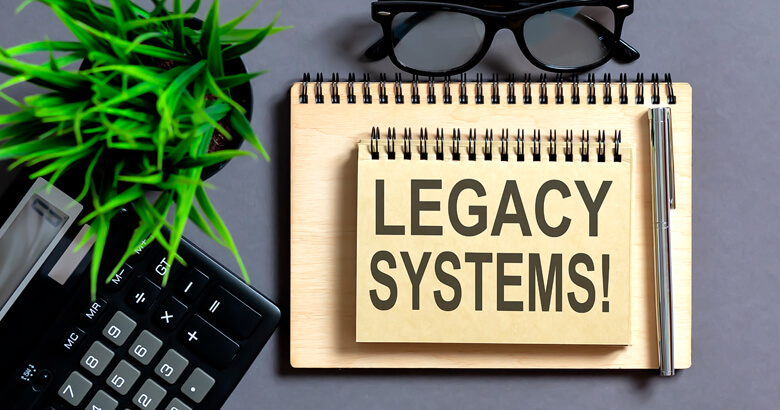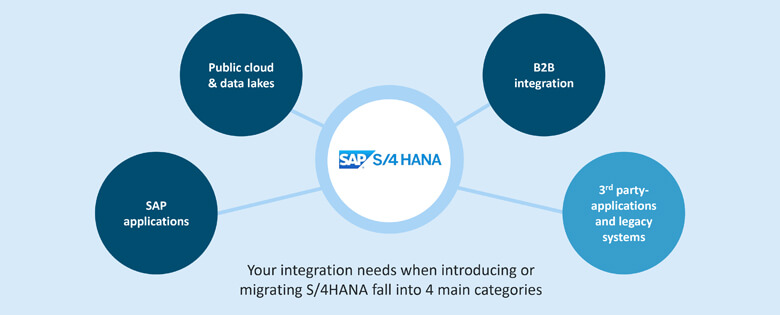
Depending on a company’s specific IT landscape, its industry, its digitalisation strategy and whether it is following a multi-cloud strategy, the complexity and work involved in integrating various processes and endpoints when migrating to SAP S/4HANA varies greatly. However, simply put, the integration you need to tackle before implementing S/4HANA can be categorised into 4 groups:
- 3rd party applications and legacy systems
- B2B integration
- Public cloud and data lakes
- SAP applications
This blog post looks at integrating 3rd party applications and legacy systems when migrating to SAP S/4HANA.
Integrating 3rd party applications and legacy systems with S/4HANA
 Figure 1: S/4HANA integration with 3rd party applications and legacy systemens
Figure 1: S/4HANA integration with 3rd party applications and legacy systemensAs a rule, SAP users tend to also employ a number of 3rd party (non-SAP) solutions to cover their business needs. These may be based in the cloud or on premises. In our blog post Integrating your Existing Products with SAP S/4HANA- Don’t Underestimate the Task! we discovered that on average, only 30% of integrative mappings are to or from an SAP application. That means that 70% of integrations are for non-SAP systems or external partners.
3rd party software which is frequently integrated with SAP S/4HANA
Cloud-based business applications
Thanks to an influx of agile providers of business applications, particularly for the cloud, the number of customers using third-party solutions has steadily grown over the last decade. Prominent examples here include Salesforce, Workday, ServiceNow and Coupa. Some companies also use Microsoft Dynamics 365 alongside to their SAP ERP. The well-known American software house’s product is an ERP and CRM solution based in the cloud. There are also a multitude of on premises systems in use throughout the business world, covering a variety of specific needs. Whether on-prem or cloud-based, these third party offerings are clearly meeting needs for which customers are not currently finding satisfactory solutions from SAP.
Trading platforms, e-Commerce solutions, ecosystems and service providers
In addition to the above, companies also use further external systems, trading or collaboration platforms and e-commerce offerings (such as Amazon’s marketplace offering or Shopify’s range of retail services for the shops hosted on their platform) in their business processes. This is to an extent dependent on the industry – for example, Transporeon is a platform heavily used in the logistics industry in German-speaking Europe. And the internationally recognised PayPal, heavily used in online retail and beyond, may also a platform a number of companies need to integrate.
The challenges in integrating 3rd party applications and legacy systems with S/4HANA
Any 3rd party applications will have technical, process-related and semantic requirements which need to be considered when integrating their data structures into SAP S/4HANA. Cloud-based applications pose further challenges in e.g. firewall configuration.
Even if a number of third-party products have aimed at incorporating certain standards in e.g. data structure, the sheer range of applications and systems amplifies their differences. That is a challenge, particularly when you consider the need for process orchestration; processes and tasks seamlessly and automatically doing what the need to do, when they’re needed to do it.
Legacy systems and in-house creations are a further challenge, particularly as they often only have rudimentary interface technologies. With this limitation, what is the best, most stable way of giving access to these systems? How can the data structures be made to work within transactions with other systems? Or in a process driven by centralised master data? If these systems are going to be part of a scalable, cloud computing architecture, how can you ensure the security of these systems, and what impact will the security and firewall measures have on their integration into the architecture? Considering – and having the expertise to answer – questions like these is key to successful, seamless integration.
We shall be looking specifically at SAP S/4HANA integration for the B2B arena in a later post. Why not read more on SEEBURGER’s solutions for integrating with SAP S/4HANA? And find out more on all the aspects you need to consider in this monumental task in our posts on SAP S/4HANA integration. For one thing is clear: S/4HANA integration is best left to the experts.
Source: https://blog.seeburger.com/integrating-sap-s-4hana-with-3rd-party-applications-and-legacy-systems/
 sap-combine.com
sap-combine.com
